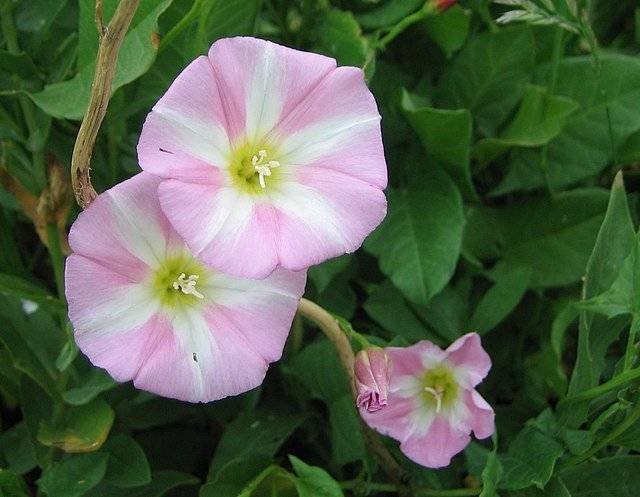Beautiful Plants For Your Interior
Bindweed

Quick Weed Facts:
Shape: Trumpet
Colour: White or Pink
Family: Convolvulaceae Genus: Convolvulus
Main Species: Hedge Bindweed (Calystegia sepium) & Field Bindweed (Convulvulus arvensis)
Other Names: Perennial Morning Glory, Smallflower Morning Glory, Creeping Jenny and European Bindweed
Most Active Growing: Spring to Late Autumn
Weed Type: Perennial
(Calystegeia sepium), the white-flowered hedge bindweed, is a common sight in fields and along roads, choking plants with its twining shoots and canes and binding them together.
(Convolvulus arvensis), the field bindweed or Morning Glory has white or pink flowers and can be a problem on bare ground and or in long grass, especially if it is not controlled.

Calystegia sepium (Morning Glory) Has White And or Pink Flowers
Is Bindweed A Problem?
If you’re wondering if this perennial weed is a problem in your garden, then generally yes, bindweed is a problem for most of us. Here’s what you need to know.
If you’ve noticed this weed growing in your garden, you’re certainly not alone. Bindweed is a common, long-living, and fast-growing perennial weed with an aggressive root system. Found in many parts of the world, this weed can be very difficult to eradicate without some serious intervention.
In a typical single infestation, plants can cover a 3ft (1m) diameter area and produce as many as 25 smaller plants. Its ‘lateral’ roots can grow as much as 10 ft (3m) per season but the ‘lateral’ roots are more easily damaged by machinery or humans. Unlike many other weeds though, bindweed has a long central taproot that can drill down to 20ft (6m) which makes this weed very difficult to eradicate completely.
In many cases, the proliferation of this weed is a sign that your soil is out of balance. This can be due to a lack of humus materials, excessive amounts of heavy metals in the soil, or improper pH levels.
However, on the plus side, if there is a plus, bindweed is a valuable early habitat for pollinators, spiders, and insects.
How To Control Bindweed?
There are two weapons that can help you in your battle against this rampant weed: vigilance and perseverance. Bindweed is the most difficult weed to deal with because you must watch out for signs of it and act quickly.
Cutting it off at ground level is the quickest and most effective method of destroying it. Do not be reluctant to pull it out of the ground; it will regrow wherever you pull up its roots, and it is nearly impossible to get all of the roots out. Continue cutting it off at ground level as soon as possible in order to eventually kill it.
Bindweed (Calystegia sepium) & (Convulvulus arvensis) thrive in open, cultivated fields and soil enriched with nitrogen. If we cannot change the fact that it thrives in open cultivated areas and we cannot prevent the germination of seeds that have been dormant in the soil, all we can do is handle bindweed as soon as we see it.
Some gardeners find that mulches (see below) or plants that shade the ground may help prevent bindweed.
My Tip: Never use a spade to dig up the roots. It just cuts them and gives hundreds more plants. Always use a garden fork and loosen the soil around the roots. Do not try to pull them out until the soil, is thoroughly loosened.
Best Weedkiller for Bindweed?
Glyphosate herbicides are the best weedkiller for bindweed. It is a ‘systemic’ weedkiller containing glyphosate, like Roundup Ultra. This perennial weed can only be killed by applying ‘glyphosate-based’ weed killers to the leaves.
The systemic eradication starts by taking the ‘glyphosate element’ from the leaves and distributing it through the root system. Weedkillers other than those containing glyphosate only eliminate the top growth. Then the plant simply regrows from the ‘roots’ if other types of weedkillers are employed.
The glyphosate must be applied to the plant’s leaves as soon as bindweed begins to flower in summer. Avoid getting this weedkiller on other garden plants as it kills everything it touches.
You may choose from several glyphosate formulations, such as glyphosate gel, ready-to-go spray, and concentrate, all of which you dilute and apply to your own sprayer.
Ensure that you follow all safety precautions, as glyphosate is thought to be associated with several human cancers in a US study, as well as being banned for municipal use in many UK councils. While glyphosate is unlikely to be used in sufficient quantities to cause harm to the home gardener, you may want to avoid using it.
How To Control Bindweed Organically?
There are several organic methods to control or eradicate bindweed. As mentioned previously, gardeners may continually cut the plant at its base to weaken it. To eradicate the plant, it is crucial to ‘dig out’ the roots. If the plant is repeatedly removed from its roots, it will eventually be killed. This may take more than one season to accomplish though.
Mulching the area with black plastic sheeting and cardboard or straw covered in a cheap fertiliser brought from a local nursery may also be effective as it stops the plant’s natural ‘photosynthesis’ which all plants need to survive. Thus it will eventually wither and die.
Weeds may also be controlled using common household items such as salt, vinegar, and lemon juice. The ingredients in your kitchen cupboard may be used to make a homemade weedkiller. Remember, although these remedies are natural and chemical-free, they do not have the same weedkilling properties as glyphosate and other commercially available weedkillers.
It’s therefore a good idea to use more than one application of this homemade weedkiller over the course of a few weeks, as one dose may not be enough to completely kill the weed. Always spray your homemade weed killer on a dry day though, otherwise, the rain will wash it away and dilute it to become ineffective.
FAQs
Is Bindweed Poisonous?
Bindweed is not considered to be toxic to humans or animals. However, it can be harmful to crops and other plants, as it competes for nutrients and can choke out other vegetation.
If you have bindweed growing in your garden or on your property, it is important to take steps to control it and prevent it from spreading.
Does Vinegar Kill Bindweed?
Vinegar can be an effective natural herbicide for controlling bindweed, as the acetic acid in vinegar can damage the plant’s leaves and roots. However, vinegar may not be as effective as chemical herbicides and may need to be applied multiple times to fully control bindweed.
Why is Bindweed Called Bindweed?
Bindweed gets its name from its habit of twining around other plants and objects, which can cause them to become “bound” or tangled up. The plant’s scientific name, Convolvulus arvensis, also refers to its twisting or winding habit, as “convolvulus” comes from the Latin word “convolvere,” which means “to twine.”
Can You Compost Bindweed?
It is not recommended to compost bindweed, as the plant’s seeds and roots can survive the composting process and may grow back in your garden. Instead, it’s best to dispose of bindweed in the trash or in a green waste bin, if available.
If you do choose to compost bindweed, make sure to remove all of the roots and seeds and to compost it in a hot compost pile to ensure that the plant material is fully broken down.
Conclusion
It’s important to remember that bindweed is incredibly difficult to control. If you have healthy, fertile, and well-draining soil, you should be able to keep it under control.
Never use a spade or a hoe to dig out the roots. Simply use a garden fork and loosen the soil around the roots. Do not try to pull it out until the soil has been thoroughly loosened.
While bindweed may seem like a minor problem when you first notice it, it can quickly become a huge issue if you don’t take action. If you see bindweed in your garden, you should always try to remove it or at least cut it back as quickly as possible. It’s important to note that if the plant survives, it can quickly grow back very quickly.
Don’t forget to visit our FAQ page for more gardening tips, tricks and information on a whole host of subjects for the home and garden.
